 Rover
75 is the company's first new model developed under the influence of
BMW.
When Rover is announcing substantial loss, inevitably its employee
expect
the new 75 to be the Saviour. Unluckily, base on the road test
impression,
it is not likely to do so. Rover
75 is the company's first new model developed under the influence of
BMW.
When Rover is announcing substantial loss, inevitably its employee
expect
the new 75 to be the Saviour. Unluckily, base on the road test
impression,
it is not likely to do so.
The 75 is intended to succeed both the Honda-derived 600 and 800 Series. Remember the 800 ? It was launched in 1987 based on the contemporary Honda Legend. The 600 appears in 1993 as a sister car of Accord. As BMW bought Rover in 1994, tie between the latter and Honda was axed, leaving Rover to develop its own car. Component sharing between Rover and its new owner was never extensive, even in the 75 we can only see the rear suspensions, a diesel engine and numerous equipment. Platform sharing is even impossible, as BMW is always rear-wheel-drive while Rover decided to remain FWD. In the era of cost-sharing, this is not a wise decision. No wonder BMW's CEO Bernd Pischetsrieder pay the price - he was sacked in January 99 because of his inability to stop Rover from heavy loss. For a modern car, 75's packaging is an appealing flaw. When it is supposed to take up the job of the 800 Series, it does not provide more room than the outgoing 600. Sure, it has the dimensions and weight ought to be a roomy sedan - its 2745mm wheelbase exceeds the European Accord and Lexus IS200 by 75mm, or surpasses its cousin BMW 3 Series by 20mm. Its length, at 4745mm, even overwhelms the 3 Series by 274mm and Accord by 150mm, a large portion of which is spent on the overhangs. The extra dimensions translate to an astonishing 1515 kg kerb weight for the 2.5 litres V6 version, heavier than the V6-powered Alfa 156 by a massive 140kg or the 328i by 75kg ! Nevertheless, the front-wheel-drive Rover, equipped with a rear suspension similar to the 3-Series's Z-axle, provides no more cabin space than the rear-wheel-drive BMW. What a nonsense ! Under the bonnet there could be either a 120hp 1.8 litres K-Series inline four, a familiar 2.5 litres KV6 with 175hp or its new 2-litres, 150hp sister. To cope with the heavy chassis, the largest engine may be the best choice. The KV6 used here gains 2 more horsepower from 825's unit, it also has heavier flywheel to negate the rev-happy manner it used to have. This makes a more grown up, refined motor, still smooth and quiet. Pushing the 1515kg, don't expect 0-60mph could come close to 8 sec even with the help of manual shifter. Top speed, at 134mph, is also disappointed for a car possessing Cd 0.30 and 175hp. The lack of driver appeal also appears in handling - soft suspensions leads to excessive body roll, steering feels artificial. Like others ordinary FF cars, mild understeer occurs when the car is reaching its cornering limit. In contrast, ride is super smooth, especially bump absorption at low speed is virtually unmatchable. Both the front MacPherson strut and the rear Z-axle are mounted on subframes, in addition to the rigid chassis, no wonder it rides so good. Moreover, the heavy kerb weight also reduces the unsprung weight in percentage. Obviously Rover deliberately build the car more refined than the 3-Series so to avoid direct competition. What a pity they forgot the BMW had already sacrificed some driver appeal to achieve higher refinement. This make the Rover 75 too refined, just like the Japanese luxury we used to know. However, at least the Rover has a distinctive, graceful interior to avoid confusion with Japanese cars. The twin dial dashboard is a result of retro design. Wood and leather surround the whole cabin. The LCD TV screen integrated with satellite navigation comes from BMW.... in addition to the chromed windows frames, belt lines, door handles etc., it makes you feel like driving a Royal limousine. Of course, the
Royal experience
won't be cheap, even it does not offer more real comfort, real
practicality
and real driving excitement. |
| The above report was last updated on 22 Feb 99. All Rights Reserved. |
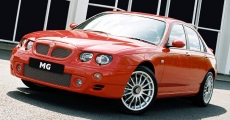 MG
must thanks to BMW, not just for its generous selling the company for
£10,
offering £400 million pocket money and gifting it tens of
thousands
of unsold cars, MG should thanks BMW for developing the 75 so good,
allowing
them to make this MG ZT so good. The 75 always has a very stiff chassis
and a sophisticated rear suspensions adapted from BMW’s Z-axle, both
elements
are crucial to driver appeal. Why the car doesn’t turn out to be a
driver’s
car is because BMW deliberately tuned it to bias towards comfort in
order
to prevent direct competition with its own 3-series. Therefore the 75
has
very soft suspensions setup and soft bushings that isolate the
suspension
subframes from the monocoque. No wonder it offers first-class ride
comfort.
MG
must thanks to BMW, not just for its generous selling the company for
£10,
offering £400 million pocket money and gifting it tens of
thousands
of unsold cars, MG should thanks BMW for developing the 75 so good,
allowing
them to make this MG ZT so good. The 75 always has a very stiff chassis
and a sophisticated rear suspensions adapted from BMW’s Z-axle, both
elements
are crucial to driver appeal. Why the car doesn’t turn out to be a
driver’s
car is because BMW deliberately tuned it to bias towards comfort in
order
to prevent direct competition with its own 3-series. Therefore the 75
has
very soft suspensions setup and soft bushings that isolate the
suspension
subframes from the monocoque. No wonder it offers first-class ride
comfort.
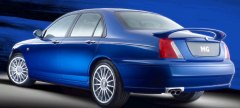 New
body work include an aggressive mesh grille / air intake / bumper, the
usual side skirts and a rear spoiler, all designed by the famous Peter
Stevens. Although the nose look too complicated and the rear spoiler is
not coherent with the dropping boot, the changes do inject a powerful
statement
necessary to establish a dynamic image.
New
body work include an aggressive mesh grille / air intake / bumper, the
usual side skirts and a rear spoiler, all designed by the famous Peter
Stevens. Although the nose look too complicated and the rear spoiler is
not coherent with the dropping boot, the changes do inject a powerful
statement
necessary to establish a dynamic image. 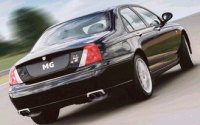
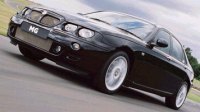 By
any standard, the conversion from ZT190 to ZT260 is brave and radical.
The differences between them is far more than the 70 extra horsepower
suggested.
To get the extra power, MG sourced a 4.6-litre V8 from the American
Ford
Mustang (like many British sports car specialists are doing). The sohc,
2-valve-per-cylinder engine pumps out 260hp and as much as 302lbft of
torque
like the stock Mustang GT. It lifts the performance of the ZT a lot -
155mph
flat out, 0-60mph takes 6.2 sec. Accompany with that is a typical
rumble-bumble
engine note and a big-car-feel torque delivery.
By
any standard, the conversion from ZT190 to ZT260 is brave and radical.
The differences between them is far more than the 70 extra horsepower
suggested.
To get the extra power, MG sourced a 4.6-litre V8 from the American
Ford
Mustang (like many British sports car specialists are doing). The sohc,
2-valve-per-cylinder engine pumps out 260hp and as much as 302lbft of
torque
like the stock Mustang GT. It lifts the performance of the ZT a lot -
155mph
flat out, 0-60mph takes 6.2 sec. Accompany with that is a typical
rumble-bumble
engine note and a big-car-feel torque delivery.
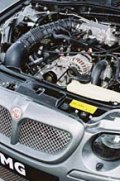 So,
this is the first rear-drive Rover sedan for 20 years ! also the first
V8-powered Rover sedan for the same period. But unlike the last Rover
3500,
it is a compact car, in the same size of BMW 3-series and offers little
room inside. Its identity is not clear - Rover wants to target it at
BMW
330i, even set its price right at the same level, but its American V8
and
limited production scale of 1,000 units a year make it more like a
tuner’s
car than a proper performance executive compact. Anyway, we welcome the
addition of such a special car in a market dominated by similar
machines.
So,
this is the first rear-drive Rover sedan for 20 years ! also the first
V8-powered Rover sedan for the same period. But unlike the last Rover
3500,
it is a compact car, in the same size of BMW 3-series and offers little
room inside. Its identity is not clear - Rover wants to target it at
BMW
330i, even set its price right at the same level, but its American V8
and
limited production scale of 1,000 units a year make it more like a
tuner’s
car than a proper performance executive compact. Anyway, we welcome the
addition of such a special car in a market dominated by similar
machines.